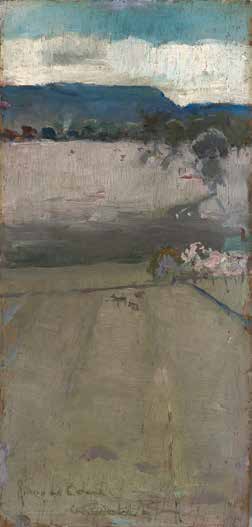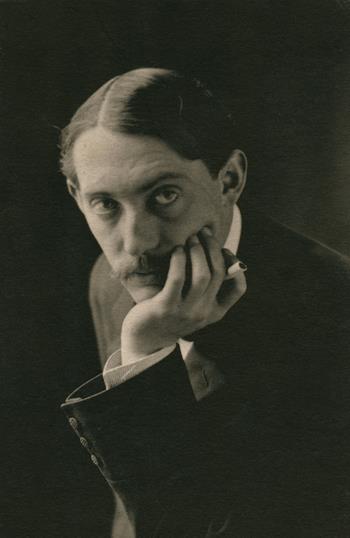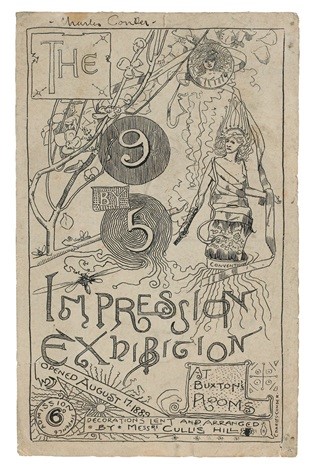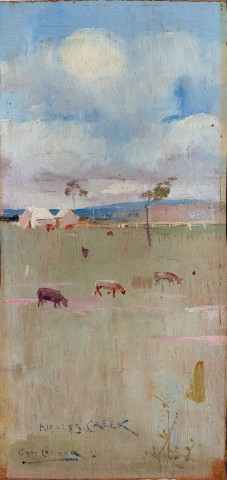THE THREE COWS, 1889
CHARLES CONDER
oil on cedar panel
23.0 x 10.5 cm (irreg.)
signed and inscribed with title lower left: RIDDLE’S CREEK [sic] / Chas Conder
Auction of paintings by Conder, Roberts, Streeton and Others, Shevill and Co., Melbourne, 24 October 1889
Dr Douglas Stewart, Melbourne
Fine Private Collection of Water–Colour Drawings and Oil Paintings by Well–Known Artists, Gemmell, Tuckett and Co., Melbourne, 30 April 1920, lot 91
Dr U. Harper Bell, Melbourne, by 1938
Sir Reginald Marcus Clark, Sydney
James R. Lawson, Sydney, 15 June 1954, cat. 29 (as ‘Riddle’s Creek’)
Mrs Agnes Buchanan, Sydney
Thence by descent
Private collection, Sydney
The 9 by 5 Impressionism Exhibition, Buxton’s Rooms, Melbourne, 17 August 1889, cat. 146 (as ‘The Three Cows’)
Australian Impressionism, The Ian Potter Centre: NGV Australia at Federation Square, Melbourne, 31 March – 8 July 2008, cat. 9.14
Osmond, S., Table Talk, Melbourne, Friday 2 August 1889, p. 7
Gibson, F., Charles Conder: His Life and Work, John Lane, The Bodley Head, London, 1914, p. 94 (as ‘The Three Cows’)
Rothstein, J., The Life and Death of Conder, Dent, London, 1938, pp. 29, 285 (as ‘Riddle’s Creek’, coll. of U. Harper Bell)
Hoff, U., Charles Conder. His Australian Years, National Gallery Society of Victoria, Melbourne, 1960, cat. 35, pp. 22 – 23 (as ‘Riddle’s Creek’)
Hoff, U., "Charles Conder", Art and Australia, Ure Smith, Sydney, vol. 2, no. 1, May 1964, pp. 34, 36 (illus., as ‘Riddles Creek’)
Hoff, U., Charles Conder, Lansdowne, Melbourne, 1972, cat. C49, no. 10, pp. 11, 32, 37 (illus., as ‘Riddle’s Creek’), 101
Lane, T., Australian Impressionism, National Gallery of Victoria, Melbourne, 2007, cat. 9.14, pp. 166 (illus., as ‘The Three Cows’), 329
Riddells Creek, 1889, oil on wood panel on paper on two layers of cardboard, 24.4 x 11.2 cm, in the collection of the National Gallery of Australia, Canberra
NOVL21 Cat proof 7_10_2021 B (2) (002).jpg

The 9 by 5 Impression Exhibition, held in August 1889 at Buxton’s Rooms on Melbourne’s busy Swanston Street, is one of the most celebrated in this country’s history. Surviving works show it was full of artistic gems. Directed by Tom Roberts, Arthur Streeton and Charles Conder, the event was well staged. A publicity agent, Sophie Osmond of Melbourne’s Table Talk, was engaged to set the scene with a series of articles, as the exhibition itself provocatively promoted Impressionism and Aestheticism to challenge the conservative tastes of the time.1 In the catalogue announcement ‘To The Public’ the artists stated:
‘An effect is only momentary: so an impressionist tries to find his place. Two half-hours are never alike, and he who tries to paint a sunset on two successive evenings, must be more or less painting from memory. So, in these works, it has been the object of the artists to render faithfully, and thus obtain first records of effects widely differing, and often of very fleeting character.’2
Conder designed the catalogue cover in bold, beguiling line. The perplexed figure of art, bound by the bands of convention, is being stripped free. And Buxton’s gallery was specially decorated in Liberty silks and dry flowers of Aesthetic inclination. Special musical recitals were held on Wednesday afternoons. The desired publicity, or notoriety, was achieved through the stinging attack launched by James Smith, the highly influential art critic for The Argus. His hostile review included the words: ‘…something like four-fifths are a pain to the eye’.3 Controversy raged. Smith did, nevertheless, select some artists and their works for favourable comment: ‘These and a few others afford something agreeable for the eye to rest upon…’. Conder’s Myosotis (whereabouts unknown) was one of them.
Of the 182 small-scaled works exhibited, 60 were by Roberts, 41 by Streeton, 46 by Conder and four by Frederick McCubbin, including one titled ‘Still Glides the Stream’ (whereabouts unknown).4 A select number are now among the treasured holdings of our national, state and regional art galleries. Twelve are by Conder. They include Impressionists’ Camp, 1889; Herrick’s Blossoms, c.1888; and Riddells Creek, 1889 (all in the collection of the National Gallery of Australia, Canberra); Sketch Portrait, c.1889 (National Gallery of Victoria, Melbourne); An Impressionist (portrait of Tom Roberts), 1889, (Art Gallery of New South Wales, Sydney); How We Lost Poor Flossie, 1889 and Dandenong from Heidelberg, 1889 (Art Gallery of South Australia, Adelaide); and Dusk, 1889 (Art Gallery of Ballarat). Of these, the most interesting from the point of view of our painting, is the companion piece, Riddells Creek in the National Gallery of Australia. For many years both were in the collection of Dr Douglas Stuart, having been purchased by him from the Auction of paintings by Conder, Roberts, Streeton and Others at Shevill and Co., Melbourne, on 24 October 1889. They are illustrated side by side in Ursula Hoff’s article on Conder in Art and Australia in May 1964, misleadingly carrying the same title of ‘Riddles Creek’.5 This confusion is no doubt due to both paintings having been inscribed ‘RIDDLES CREEK’ by Conder.
The township of Riddells Creek, in the southern foothills of the Macedon Ranges, is about an hour’s drive northwest of Melbourne. Conder visited there not long before the opening of The 9 by 5 Impression Exhibition. Journalist Sophie Osmond noted in Table Talk of 2 August 1889 that Conder had visited Riddells Creek, ‘to study the scenery of the district’.6 This is supported by Conder’s letter to his cousin Maggie, in which he wrote: ‘I have been staying at Riddels [sic.] Creek for a few days with Mrs Caffyn’.7 (During his Melbourne years, Conder had a close friendship with the novelist Kathleen Caffyn, who became his muse and his model. She, in turn, based one of the characters in her novel, A Yellow Aster, on Conder.8)
210675 Charles-Edward-Conder.jpg

While our painting and the one in the National Gallery of Australia are inscribed ‘RIDDLES [sic] CREEK’, when exhibited in The 9 by 5 Impression Exhibition, the National Gallery’s painting was given the title ‘Riddell’s [sic.] Creek’ and our painting, ‘The Three Cows’. As noted by Mary Eagle in her book on Conder’s works in the National Gallery, both paintings have three cows, although they are more prominent in the latter. She also suggests that they ‘may have been painted on the same day’.9 If so, The Three Cows would have been first, as indicated by the light and other signs of the times of day. The absence of shadows suggests noontide and the cows graze happily in ordered line. The mood of pastoral peace continues through other images of settlement. Bright sunlight shines from the white-roofed, pink-walled homestead and dissipates the rain-bearing touches of grey on the cumulus clouds. Capturing the transient in paint, joy is characteristically touched by melancholy as sensuous pinks cohabit with fields of pale greens, all enlivened by the engaging movements of the brush and general upward movement. The fence line, reinforced by the distant hills of the horizon, divides the composition in two, almost equal, parts. All is balanced as quietude reigns in this vision of the poetic dreamer. The foreground is largely devoid of imagery, filled instead by subtle colour harmonies and the play of brushstrokes that speak of the visual pleasures found in abstract art.
The National Gallery of Australia’s Riddell Creek, 1889, almost identical in size and likewise vertical in format, provides an aerial view of a different direction. Looking into the now dimmed light as the cows rest from eating, Conder confirms the Impressionist credo – ‘Two half-hours are never alike’.10 A special cluster of colourful twists of paint translated into spring blossoms adds Oriental asymmetry, heightening the imaginative interpretation of the landscape so characteristic of Conder. Flatness is balanced by depth.
In the decorative use of colour, both paintings share directness, sophisticated simplicity, and a striking open-air feeling, blended with the lyricism for which Conder’s Australian works are so admired. As Ursula Hoff pointed out: ‘In most of these works, however, the strongly decorative trend inherent in Conder’s nature holds his realism in balance. He uses his arrangement and colour to create harmony, to express feeling’.11 Some paintings, especially those which are felt as much as seen, are engagingly ephemeral, enveloped in a poetic atmosphere. Others are permeated with an aqueous feel, the remarkable fluidity of his oil paint showing a likeness to watercolour technique. In her study of Conder’s paintings in the National Gallery of Australia, Mary Eagle commented on his ‘watercolour style of applying oil paint’ and its ‘transparency’. Referring to Bronte Beach, 1888, she also observed that Conder ‘pioneered various other stylish conceits such as the Japanese style twigs on the lower left of Bronte Beach’.12 A similar such touch of plants is provided in the very forefront of The Three Cows. Other Japanese-inspired elements include its narrow format, flatness, individuality of design and exact placement of objects.
210675 9 x 5 exhibition catalogue.jpg

A number of influences contributed to the development of Conder’s style. In Sydney, he drew freelance for the Illustrated Sydney News, attended the outdoor art classes conducted by A.J. Daplyn and, in 1888, joined Julian Ashton’s evening sketch club. That same year saw a concentration of activities and achievements. At Easter, he painted at Coogee with Tom Roberts – their sunny paintings, Coogee Bay, 1888 by Conder, and Holiday Sketch at Coogee, 1888 by Tom Roberts, are now in the collections of the National Gallery of Victoria and the Art Gallery of New South Wales respectively. In July – August, Conder joined Ashton, A.H. Fullwood and others, sketching at Griffith’s Farm, Richmond, in New South Wales. Several classics followed – Herrick’s Blossoms, 1888, now in the National Gallery of Australia, and Springtime, 1888 in the National Gallery of Victoria, through the Felton Bequest in 1941. His triumph of the year was the Departure of the Orient – Circular Quay, 1888, which was snapped up by the Trustees of the Art Gallery of New South Wales from the Annual Exhibition of the Art Society of New South Wales. Embracing plein air painting and Impressionist verve, its wet effects reveal Conder’s recent debt to Girolamo Nerli, who had arrived in Sydney the year before. In May of 1888, Conder and Nerli painted together at Bronte Beach. Conder’s Bronte Beach, 1888 (National Gallery of Australia) is imbued with his characteristic inventive approach to plein airism. In October, Conder left Sydney for Melbourne, painting Holiday at Mentone, 1888 (Art Gallery of South Australia), soon after. It was his second Australian masterpiece within the year. Later works showed the growing influence of Streeton. But it is in his sketch portrait of Tom Roberts, An Impressionist, 1889 (Art Gallery of New South Wales), shown in The 9 by 5 Impression Exhibition, that Conder pays special tribute to Roberts, acknowledging him and the leading role he played in his art.
In The Three Cows and paintings of the peopled Australian landscape, Conder enlivened the staid realism of plein air painting with invention, imaginative composition, sensuous colour and handling.
1. McDonald, J., Art of Australia: Exploration to Federation, vol. I, Pan Macmillan, Sydney 2008, p. 470
2. The 9 By 5 Impression Exhibition, Buxton’s Rooms, Melbourne, 1889
3. Smith, J., ‘An Impressionist Exhibition’, The Argus, 17 August 1889, p. 10
4. The 9 By 5 Impression Exhibition, Buxton’s Rooms, Melbourne, 1889, cat. 177
5. Hoff, U., ‘Charles Conder’, Art and Australia, Ure Smith, Sydney, vol. 2, 1 May 1964, p. 36
6. Osmond, S., Table Talk, Melbourne, 2 August 1889, p. 7
7. Conder to Maggie Conder [August 1889], Mitchell Library AC134, State Library of New South Wales, Sydney, quoted in Eagle, op. cit., p. 46
8. A Yellow Aster was published in London in 1894 under the pseudonym ‘Iota’.
9. Eagle, M., The Oil Paintings of Charles Conder in the National Gallery of Australia, National Gallery of Australia, Canberra, 1997, p. 46
10. The 9 By 5 Impression Exhibition, Buxton’s Rooms, Melbourne, 1889
11. Hoff, U., Charles Conder: His Australian Years, National Gallery Society of Victoria, Melbourne, 1960, p. 14
12. Eagle, op. cit., p. 20
DAVID THOMAS
